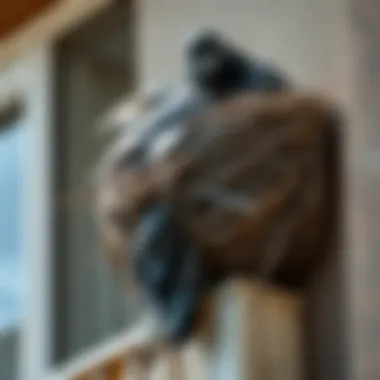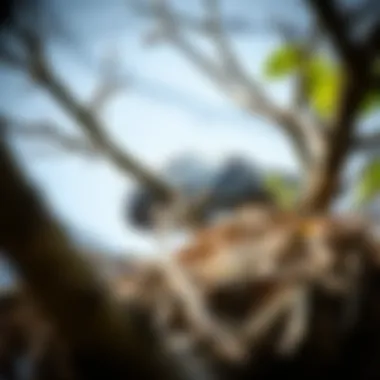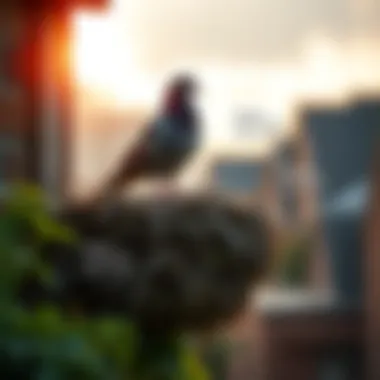Guidelines for Removing Pigeon Nests: Key Considerations


Intro
Dealing with pigeon nests can be a real conundrum for homeowners. Many people find themselves at a crossroads, pondering whether or not to remove a nest they’ve discovered in the eaves of their house or in a nearby tree. Before making any drastic moves, it’s crucial to navigate the murky waters of laws, ethics, and practicality surrounding this issue. The goal here isn't just to rid your space of these feathery nuisances; it's about understanding the broader implications of removal, from ecological impacts to humane treatment of these and other birds.
This guide offers clarity on the intricate landscape of pigeon nest removal. We'll break down legal regulations that uphold the protection of certain bird species, delve into the ecological consequences of disruption, and provide you with alternative methods at your disposal. By the end of this discussion, you'll be better equipped to make a well-informed decision.
Understanding Pests
Definition of Pests
Usually, a pest is an organism considered detrimental to human interests, mainly because it disrupts our daily lives, either by causing damage or by being an annoyance. Pigeons fall into this category for many homeowners. Their cooing can be heard all around, especially in urban settings, creating a symphony that some find melodious while others perceive as a nuisance. They build nests in various places, often creating unsightly messes and potential health risks.
Importance of Pest Identification
Identifying whether pigeons in your area can indeed be classified as pests is the first step. Not every bird is inherently harmful; some provide ecological benefits, such as pest control and pollination. Understanding the specific behavior and impact of pigeons helps homeowners address issues more strategically.
Prevention Techniques
Home and Garden Preventative Measures
Taking proactive steps can significantly reduce the allure of your property to pigeons. Here are some effective techniques:
- Block potential nesting sites: Make use of netting or spikes to discourage pigeons from roosting or nesting.
- Limit access to food: Secure trash cans and avoid leaving food outdoors that might attract birds.
- Use visual deterrents: Items like reflective tape or plastic owls can scare pigeons away.
Seasonal Prevention Tips
Pigeon activity can vary by season. Early spring is prime nesting time, so preparing beforehand is essential. Keep a watchful eye during this period, and consider implementing stronger barriers or deterrents as the weather warms up.
Eco-Friendly Pest Control Solutions
Overview of Sustainable Practices
When faced with a pigeon problem, many people might instinctively reach for harsh chemicals or traps. Instead, honest consideration for humane and eco-friendly practices is vital.
Utilizing natural deterrents is far more respectful to the environment and contributes positively to local ecosystems.
Natural Remedies and Their Effectiveness
Some natural substances are said to repel pigeons. While results may vary, they are worth exploring. Here are a few:
- Pepper and Chili Powder: Sprinkling these around nesting areas can discourage pigeons.
- Garlic Spray: A mixture of water and garlic is thought to ward off birds.
Each of these methods has its pros and cons. Assess them through careful observation, as what works for one homeowner might not suit another’s situation.
Remember, it’s important to consider the laws and the ethical aspects of any action you take. Ignoring these can lead to consequences more significant than just dealing with birds.
These steps can help you balance your needs with the environment, ensuring a solution that minimizes harm to both you and the wildlife in your area.
Preamble to Pigeon Nest Removal
Removing a pigeon nest might sound like a simple task, but there’s a lot more to it than meets the eye. The significance of understanding how to properly handle the removal of pigeon nests cannot be understated. As urban environments expand, so does the presence of these birds, leading to potential conflicts between homeowners and wildlife. Knowing how to navigate this delicate balance is essential for both ethical and practical reasons.
Before jumping into action, it's important to realize that pigeons, despite being considered pests by many, play a role in our ecosystem. Making informed decisions about their nests is vital for maintaining this balance. Mishandling their nests could lead to legal issues, ecological consequences, and even the possibility of harming the birds. Therefore, educating oneself on the guidelines surrounding pigeon nest removal stands as a necessity for anyone dealing with this scenario.
Beyond simply following the law, understanding the implications of one’s actions can lead to better outcomes for the community and the wildlife it hosts. Take into account factors such as the timing of removal and whether nests are active or abandoned. Not only does this knowledge help in making better decisions but it also assists in finding more humane methods of dealing with these situations, facilitating a smoother coexistence with nature.
In essence, tackling the question of pigeon nest removal involves gathering knowledge from various perspectives—legal regulations, ecological impacts, and behavioral understanding of pigeons. This approach creates a more sustainable and respectful interaction between humans and wildlife.
Understanding Pigeon Behavior
Pigeons are often dismissed as mere nuisances, but if you really take a moment to look at them, you would see that their behavior offers insight into why they choose certain areas for nesting. For instance, they're particularly loyal to specific sites, which serves a purpose in their instinctual behavior. These birds commonly seek out high, sheltered spots that provide protection from predators, rain, and strong winds. Commonly, they’re fond of ledges, rooftops, and other elevated surfaces within urban landscapes.
Pigeons, particularly feral ones, are known to be highly adaptive creatures. This adaptability is quite fascinating as it demonstrates the birds’ ability to thrive in environments heavily influenced by human activity. They form strong pair bonds and often return to the same nesting site year after year because of their strong homing instincts. If you have noticed a nest recently, it’s likely because the pigeons have built a dedicated home for their offspring. These social structures are integral to their survival, which is why understanding their behavior is key to handling nest removal correctly.


Common Locations for Nests
When it comes to locating pigeon nests, knowing their favorite hangouts can save you plenty of time and hassle. Pigeons often prefer nesting in places that offer some kind of safety net against the hustle and bustle of urban life.
- Building Cornices: Flat, ledged areas on the tops of buildings are like luxury high-rises for pigeons. They provide a great vantage point to survey the surrounding area while keeping youngsters out of harm's way.
- Balconies: Many homeowners unknowingly offer prime real estate for pigeons. If you have a balcony, it’s not unusual for a pigeon to view it as an inviting nesting area, especially if it is quiet and somewhat sheltered.
- Bridges and Overpasses: These are favorite spots as well, since they shield pigeons from rain, wind, and predators.
- Awning and roof eaves: Many businesses find themselves with surprise pigeon nests in these areas, since they offer the right blend of shade and security.
Each of these locations appeals to the pigeon's nesting habits in unique ways, often driven by their instincts for safety and survival. If a nest is found in these spots, it often raises questions about what actions to take next. Instead of jumping to conclusions, it's critical to pause and evaluate the situation with care and consideration.
Legal Considerations
Removing a pigeon nest is not a simple task. It comes with a set of legal implications that one must take seriously. Understanding local laws and regulations pertaining to wildlife is crucial for several reasons. First, it helps avoid potential fines or penalties, which can be steep if you infringe on protected species laws. Secondly, it ensures the humane treatment of animals, which is an ethical responsibility that goes beyond mere compliance with regulations. Above all, being informed allows homeowners to make decisions that are not only legal but also considerate of the ecosystem they are a part of.
Local Laws on Wildlife Protection
Laws vary widely by region when it comes to wildlife protection. In many places, pigeons are protected under both local and national regulations that aim to preserve urban wildlife. For instance, in parts of the United States, the Migratory Bird Treaty Act prohibits the removal of nests if they contain eggs or chicks. Even within neighborhoods, ordinances can differ significantly.
Here are some essential steps to follow:
- Research Thoroughly: Before taking any action, consult your local government or wildlife agency. Websites with a *.gov domain often hold a wealth of information pertaining to local laws.
- Check Seasonal Restrictions: Pigeons usually breed in the spring and summer, so laws may restrict removal during those months. Verify the specific times when it's permissible to act.
- Engage Local Experts: Sometimes, turning to local wildlife organizations or pest control services can provide clarity about the legal landscape. They have insights on specific guidelines and even can offer details on how to handle the situation legally.
Ignoring these laws not only jeopardizes the welfare of birds but can also lead to unnecessary legal troubles. Therefore, knowledge about local wildlife laws is crucial if one is considering removing a pigeon nest.
Permits Required for Nest Removal
In addition to understanding laws, many regions require permits for the removal of pigeon nests. This may seem like a bureaucratic hurdle, but these permits often serve a significant purpose: they help regulate the treatment of wildlife and ensure that removal is done in a responsible manner.
Consider the following:
- Permit Application Process: Typically, obtaining a permit involves submitting an application to your local wildlife office, outlining your reasons for removal. Depending on the jurisdiction, this could be a fairly straightforward process, ranging from filling out a form to providing evidence that nests are problematic.
- Evaluation Period: After application submission, there is often a waiting period during which the local wildlife agency reviews your request. They may also conduct an on-site inspection. This evaluation is not merely a formality; it serves to verify that the removal is warranted and that all other avenues have been explored.
- Cost Implications: Be aware that permits may have associated fees. It’s crucial to budget for these costs as part of your nest removal plan.
In sum, taking the required legal steps both ensures you act within the law and contributes to the humane treatment of pigeons and the health of the broader urban ecosystem. As one might say, "You can't put the cart before the horse." So it's vital to ensure that you adhere to all legal guidelines before attempting to remove any nests.
Ecological Impact of Removal
Removing a pigeon nest is not just a simple act. It carries a multitude of ecological consequences that extend far beyond the immediate act of nest removal. Understanding these implications is vital for homeowners and property managers alike, as it encourages a more informed and responsible approach to wildlife interactions. In urban environments, where nature often struggles to thrive, pigeons play an essential role in the ecosystem. This article section will delve into the role of pigeons in urban ecosystems and the potential consequences that arise from displacing their nests.
Role of Pigeons in Urban Ecosystems
Every creature in an ecosystem plays a part, and pigeons are no exception. Although they are often seen as pests, pigeons contribute to urban environments in several significant ways.
- Seed Dispersal: Pigeons help in the dispersal of seeds, which can be crucial for plant diversity, especially in city parks and gardens.
- Food Source: They serve as a food source for various predators, including hawks and falcons. These birds, which many urban dwellers enjoy spotting, rely on pigeons for survival.
- Biological Indicators: Pigeons behave as bioindicators, reflecting the health of the urban environment. A thriving pigeon population can highlight a balanced ecosystem.
These contributions illustrate that pigeons are more than intrusive guests. Their presence often indicates a lively ecosystem where various species interact, leading to a vibrant urban habitat.
Consequences of Displacing Nests
When a pigeon nest is removed, the immediate shift can have broader environmental implications. Understanding these consequences can shape the decisions residents make regarding nest removal.
- Disruption of Breeding: If nests are removed during the breeding season, it can lead to the abandonment of eggs or chicks. This not only affects the pigeons themselves but can also alter food chains.
- Increased Competition: Displacing a nest creates a void in the ecosystem, which might be filled by less desirable species. For instance, aggressive birds may take over the space, thereby reducing the overall biodiversity.
- Emotional & Social Impact: Many residents may develop an emotional attachment to the wildlife around them. Disturbing or displacing nests can negatively affect a community’s sentiment towards nature and wildlife conservation.
"The loss of one species can have a ripple effect, influencing many others in ways we might not immediately observe."
Ultimately, considering the ecological impact when contemplating pigeon nest removal is essential. By understanding their role and the consequences of displacing nests, individuals can balance personal convenience with ecological responsibility. This careful consideration can help foster a more harmonious relationship between urban residents and the wildlife that inhabits their neighborhoods.
Assessment of Nests
Understanding the assessment of pigeon nests is crucial when considering their removal. This process helps homeowners and property managers to make informed choices, balancing the need for cleanliness and safety against the well-being of wildlife. After all, taking stock of the nests on your property aids in determining their current usage and signals any necessary actions to prevent future nesting behavior.
Engaging in a thorough assessment before any removal allows you to gauge not only the condition of the nests but their status — are they currently inhabited or abandoned? This can save you considerable trouble down the line. Active nests are often legally protected, and removing them during breeding season can introduce legal entanglements and ethical dilemmas.
Also, a chance to identify how nests are impacting your living space or property helps in choosing the best preventive measures for the future. Here are some specific elements to consider during an assessment:
- Location: Where are the nests situated? Understanding their placement (e.g., under eaves, in gutters) reveals how accessible they are and whether they are likely to be occupied.
- Material Used: Observing the nesting material can indicate how long it's been there. Fresh twigs and feathers suggest recent activity, whereas dust and decay indicate abandonment.
- Presence of Adult Birds: Spotting pigeons around the nests can clarify if they are actively breeding.
- Health of Nest Structure: Collapse or disrepair may suggest age and possible abandonment. A sturdy nest typically indicates a maintained environment that could still be in use.


In taking these elements into account, you enhance your understanding of the nest's life cycle and the behavioral patterns of the pigeons, which can lead to more effective management strategies. It isn’t just about finding out if you can remove a nest; it’s about discerning the best course of action that aligns with both legal standards and environmental care.
Identifying Active vs. Abandoned Nests
Identifying whether a nest is active or abandoned is more than an interesting puzzle; it’s a key consideration in deciding your next steps. An active nest, typically cramped with squawking chicks or vigilant parent pigeons, needs to be treated with care. Removal at this stage can be unlawful, given that many regions protect nesting birds during specific periods.
On the flip side, abandoned nests pose a different set of challenges. These often signal a change in the area — perhaps a newly implemented deterrent, an environmental shift, or simply the waning interest of the pigeons. Distinguishing the two can usually be achieved through a couple of observational techniques:
- Watch for Activities: Take note of adult pigeons returning to the nest. Consistent visits usually indicate it’s still in use.
- Look for Fresh Materials: An uptick in new nesting material suggests occupancy. Weathered nests with old debris are often clear signals of abandonment.
Keeping your eyes peeled for these signs helps in avoiding any unwanted surprises when it comes to removal. In the end, timely identification makes for a smoother operation and a better relationship with the natural world.
Timing of Nest Removal
Timing is everything, especially with regard to the removal of pigeon nests. There’s a lot more than just grabbing a ladder and scooping it out during a weekend clean-up. It draws from a mix of legal, ethical, and practical considerations. The best time, practically speaking, depends greatly on the breeding cycle of the pigeons, which often peaks in the warmer months.
In many areas, it’s in your best interest to wait until the young are fledged—typically around 4 to 6 weeks after they are born. This not only complies with nature’s rhythm but also aligns with potential wildlife regulations. Here are important timing factors to consider:
- Seasonal Variations: Early spring through summer often sees increased nesting activity.
- Breeding Cycles: Familiarizing yourself with the local pigeon breeding schedule can provide insight into when it’s least disruptive to remove nests.
- Weather Conditions: If storms or extreme weather is approaching, you might opt to delay removal to avoid further distress for the birds.
Ultimately, the goal is to make nest removal as humane as possible. Timing it right can steer clear of the chaos that might ensue when young birds are relying on their nests for refuge. Not only does this consideration speak volumes about your thoughtfulness, but it can also minimize potential backlash from both the birds and the environmental regulators who oversee wildlife protections.
"Choosing the right time for nest removal not only respects wildlife but also fosters a positive relationship between you and the local ecology."
Being mindful about your choices in these assessments ensures a balanced approach to property maintenance. Armed with teamwork, awareness, and educated decisions, you can navigate pigeon management with a level of skill and care that truly reflects a conscientious approach.
Methods of Nest Removal
Removing pigeon nests is not just a matter of convenience; it's a crucial task that requires consideration of various aspects. This section dives into the methodologies available for removing these nests and their implications. The choice of method can impact not just the immediate environment but also the surrounding ecosystem, legal implications, and ethical concerns. Understanding how to navigate these waters is vital for homeowners and property managers alike.
Manual Removal Techniques
Manual removal of pigeon nests requires a hands-on approach. It can be effective, especially in dealing with small numbers of nests or in areas where the annoyance of pigeons is localized. Here are some key points to remember when opting for manual removal:
- Timing: The best time to remove a nest is when it is abandoned. If you remove a nest during the breeding season, you risk leaving young birds orphaned, which can lead to legal repercussions.
- Safety Measures: Always wear gloves and a mask. Pigeon droppings can harbor pathogens, so personal safety is paramount. Use a sturdy ladder and ensure you have someone to help if needed, as it’s easy to lose balance while reaching up high.
- Tools Required: Basic tools include a pair of gloves, a sturdy trash bag, and possibly a broom or a scraper to remove residual materials. Be cautious if the nest is in a tough-to-reach place.
Remember, the success of manual removal hinges on taking the right precautions and timing it well.
Chemical Solutions and Their Risks
While chemicals might seem like an easy way to deal with nests and deter pigeons, they come with significant risks. Understanding these risks is crucial before considering chemical approaches:
- Potential Harm: Chemicals can be harmful not just to pigeons but to pets, local wildlife, and even humans. It's essential to consider the broader ecosystem before using such solutions. Misuse of chemicals could lead to poisoning of non-target species, which is both unethical and illegal in many regions.
- Temporary Fix: Often, chemical methods don’t provide a long-term solution. Pigeons are quite resilient and can develop resistance to certain substances over time. Thus, even if a chemical solution seems effective at first, it may not be a sustainable choice.
- Regulatory Issues: Many regions have strict regulations regarding the use of chemicals for pest control. Always check with local authorities or pest control agencies before proceeding with this option.
Using chemical solutions should really be a last resort, reserved only for difficult situations where all other options have failed.
Consulting Professional Services
Engaging professionals to handle nest removal can be an effective approach, particularly if you're dealing with larger infestations or tricky locations. Professional pest control services offer a plethora of benefits:
- Expertise: Trained professionals understand the legal and ethical implications of removing pigeon nests. They have the knowledge needed to navigate the complexities of nest removal that a typical individual may not possess.
- Safety First: Professionals come equipped with the right tools and safety equipment. They have the experience required to mitigate risks, particularly when dealing with inaccessible or hazardous nests. This significantly reduces the likelihood of accidents.
- Comprehensive Solutions: A pest control service can not only remove nests but also help devise a long-term strategy for deterring future nesting. This may involve repairing entry points or installing barriers, ensuring that your property is not a nesting zone in the future.
In summary, while you may consider various methods for pigeon nest removal, assessing the situation carefully and weighing your options against your local legal framework, the ecological impact, and safety is paramount. The right technique can make all the difference, ultimately leading to harmonious living alongside our feathered companions.
Preventative Measures
Preventative measures are the unsung heroes when it comes to managing pigeon populations in urban settings. Rather than reacting to a pigeon problem, taking proactive steps can often save time, money, and energy in the long run. By ensuring that pigeons are deterred from making your home their home, you can prevent nesting issues before they ever begin. This section explores the practical elements involved in creating an environment that is less hospitable for these birds, as well as the long-term benefits of implementing these strategies.
Physical Barriers and Deterrents
Employing physical barriers can be an effective way to keep pigeons from nesting in your space. Options include installing netting, spikes, or even sloped surfaces that deter pigeons from settling.
- Netting: This creates an impenetrable barrier for pigeons. It can be effective over balconies, window ledges, and even in larger open areas. Proper installation ensures that there are no gaps where pigeons could squeeze through.
- Bird Spikes: Sharp, upward-facing spikes can be installed on surfaces where pigeons tend to perch. These do not harm the birds but make it uncomfortable for them to settle.
- Sloped Surfaces: If you have flat surfaces, consider redesigning them to be sloped. A surface that is not conducive to perching can dissuade pigeons from trying to nest.


Furthermore, ultrasonic devices that emit sounds uncomfortable for birds can also help keep them at bay without resorting to more aggressive measures. By integrating these physical deterrents, homeowners can drastically cut down on the likelihood of pigeons making a nest in unwanted areas.
Feeding Habits of Pigeons
Understanding pigeons' feeding habits is crucial for effective prevention. Pigeons are attracted to easy food sources, and where food is prevalent, nests usually follow. If you observe pigeons frequenting your space, it's worth taking note of what foods might be attracting them.
- Avoid Feeding: The obvious answer is not to feed pigeons. If you have a habit of leaving out birdseed or bread, it’s time to rethink that strategy. While this may seem innocuous, it only encourages pigeons to return to your space.
- Secure Trash: Ensure that trash cans are tightly sealed and not overflowing. Pigeons will scavenge for food scraps, making poorly managed waste a tasty lure.
- Cleanliness: Regularly clean patios, balconies, and yards to remove any food remnants that might attract pigeons. This minor maintenance can go a long way in dissuading them from settling.
In summary, addressing feeding habits and using physical barriers can significantly decrease the chances of pigeons nesting nearby. Both approaches are part of a holistic strategy to manage and mitigate pigeon populations effectively.
"An ounce of prevention is worth a pound of cure."
Thus, being proactive in implementing these preventative measures not only enhances your living environment but also contributes to a more humane approach in dealing with urban wildlife.
Alternatives to Nest Removal
Removing a pigeon nest might seem like the only answer when unwanted guests start nesting on your property, but there are other methods to explore. Rethinking our approach can lead to solutions that are not only more humane but also beneficial to the environment. Alternatives to nest removal focus on minimizing the factors that attract pigeons to your space in the first place and creating an environment that naturally discourages them from settling in.
By considering these alternatives, you don’t just alleviate the burden of having to deal with nests, but you also create a balance that respects local wildlife and enhances your living environment.
Habitat Modification Strategies
One of the most effective ways to steer pigeons clear of your property is through habitat modification. By altering their surroundings, you can make it less appealing for them to roost or nest. Here are several practical strategies to consider:
- Remove Sources of Food: Pigeons are like feathered vacuum cleaners; if they find food, they will stick around. Be mindful of birdseed, pet food, and any leftover scraps outside. Secure trash bins with tight-fitting lids and clean your outdoor area regularly.
- Limit Water Sources: Standing water can attract not just pigeons but a whole carnival of unwanted wildlife. Empty bird baths or water features if they are not in use. If they are necessary for another purpose, consider using netting or covers to prevent access.
- Adjust Landscaping: Sometimes, pigeons are just looking for a cozy spot. Prune trees and shrubs that provide shelter and nesting opportunities. Keep outdoor furniture covered or stored away when not in use.
- Create Noise or Movement: Pigeons are wary of sudden changes. Wind chimes, reflective materials, or even decoys can make your outdoor space less inviting. The objective is to create a little commotion that nudges them to think twice before settling in.
These modifications not only help deal with pigeons but can also enhance the overall aesthetics of your spaces, a win-win for homeowners.
Finding Eco-Friendly Solutions
There’s no shortage of ethical options when it comes to handling pigeon nests. Embracing eco-friendly solutions ensures that we respect wildlife while maintaining our living spaces. Here are some thoughts and methods that align with a more sustainable ethos:
- Natural Deterrents: Certain plants, like lavender or rosemary, can deter pigeons due to their strong scents. Strategically planting these around your home can help reduce the birds' presence without harmful chemicals.
- Ultrasonic Repellents: These devices emit high-frequency sounds that are unpleasant to birds but inaudible to humans. Positioned correctly, they can deter pigeons without causing them harm.
- Wildlife-friendly Exclusion Techniques: Instead of removing nests, consider techniques that allow for the temporary exclusion of the area. Wire mesh or netting can be installed to prevent access to potential nesting sites.
- Collaboration with Local Wildlife Organizations: Partnering with local organizations can provide education and support for humane biodiversity initiatives. They might offer services or advice on managing local pigeon populations while ensuring their survival. You might even find services offered by local animal shelters or wildlife conservation groups.
Ultimately, these alternative methods not only reflect a commitment to humane treatment of wildlife but also contribute to the ecological balance of our communities.
Incorporating these alternatives to pigeon nest removal not only highlights a deeper respect for wildlife but also fosters a healthy coexistence that can benefit everyone involved. Consider these strategies as ways to reconsider how we interact with our feathered neighbors, nurturing both our homes and the environment.
Final Thoughts
Navigating the intricacies of removing a pigeon nest is not merely a practical concern but also a significant ethical dilemma that many homeowners face. The topic of nest removal invites a multitude of perspectives, necessitating a careful balance between personal inconvenience and ecological mindfulness. Understanding the ramifications of one’s actions can influence both immediate community relations and broader environmental outcomes.
Before making any decisions, it's vital to consider the specific context of the situation. Not all pigeon nests are the same; some may be active, hosting young chicks, while others might be abandoned. This distinction is paramount, as it guides homeowners on whether to act or to adopt a wait-and-see approach. Failure to recognize this can lead to unnecessary harm to wildlife, which can ultimately affect local ecosystems.
Benefits of Thoughtful Decision-Making
- Animal Welfare: By prioritizing the welfare of pigeons, an individual can contribute positively to the balance of the ecosystem.
- Legal Compliance: Many areas have specific regulations governing wildlife protection. Abiding by these laws can spare homeowners from fines or legal repercussions.
- Community Impact: How a homeowner addresses the issue can influence neighborhood perceptions and lead to longer-lasting relationships with both people and the wildlife that share their space.
Furthermore, those grappling with nest removal should consider the options laid out in earlier sections. Utilizing habitat modification to deter pigeons or implementing humane methods of relocation can be a more thoughtful course of action. While such alternatives may not provide the immediate relief one seeks, they contribute to a solution that respects animal life and promotes sustainable coexistence.
"A stitch in time saves nine"—this old adage rings true in wildlife management. Taking the time to consider your options can prevent larger headaches down the line.
By weighing practicality against ethical considerations, homeowners can make a more informed and compassionate decision regarding pigeon nest removal. This assures that actions taken are not just about alleviating inconvenience, but also about fostering an harmonious coexistence with the environment. Courage to act ethically will not only reflect well on one’s character but can also inspire others in the community to follow suit.
Balancing Practicality and Ethics
When it comes to the issue of pigeon nest removal, the balance between practicality and ethics cannot be stressed enough. Household inconveniences related to noise and cleanliness often drive people to consider removal, yet ethical considerations surrounding wildlife should factor into those decisions. It’s not unusual for homeowners to feel pressured into immediate action when confronted by a demanding situation, but that urgency can cloud moral judgment.
Every nest removed does not just represent the loss of a bird's home, but could lead to further implications, such as behavioral changes in the local pigeon population or even unintentional harm to other species.
Striking this balance may require critical thinking and empathy. Here are some points worth considering:
- Evaluate Necessity: Is the removal absolutely essential for your living environment? Or are there adjustments that can be made instead?
- Exploration of Alternatives: Consider non-invasive options like habitat modification instead of outright removal.
- Consult Professionals: Reach out to local wildlife experts or pest control services focused on humane practices.
Resources for Further Information
As with any topic that intersects legal, ethical, and environmental concerns, having trustworthy resources can aid significantly in decision-making processes.
- Local Government Websites: Often contain valuable guidelines regarding wildlife protection. Visit your local wildlife agency’s site or *.gov resources for pertinent laws.
- Educational Sites: Websites like en.wikipedia.org or britannica.com provide insight into the ecological roles of pigeons and effective management strategies.
- Community Forums: Resources like reddit.com can provide anecdotal advice from other homeowners facing similar challenges.
- Professional Wildlife Services: Local pest management companies specializing in humane wildlife removal often have blogs or articles that can explain best practices.
- Environmental NGOs: Organizations like The Humane Society or local wildlife conservation groups may offer brochures or online resources detailing ethical approaches.
Having a well-rounded understanding of the implications tied to pigeon nest removal leads to more thoughtful and informed decisions. Balancing the immediate needs against the broader consequences of actions can foster a sense of responsibility, ensuring that our interactions with wildlife are guided by both care and respect.



